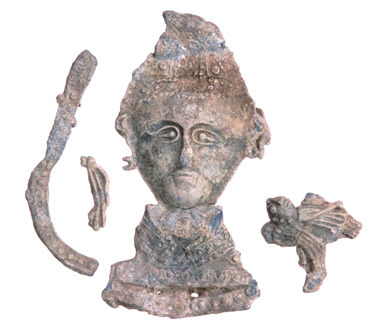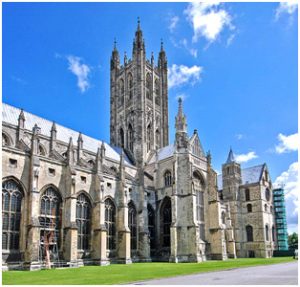
The Abbey Museum recently received a generous donation of a 14th century Pilgrim Badge of St Thomas Becket. A pilgrim badge, like the suit of armour also acquired this year, has been on the Museum’s wish list for a number of years as they represent an aspect of medieval life not previously represented in the collection.
Pilgrim Badge – Tourist Souvenir of the Middle Ages?
Pilgrimages were an important part of life in medieval England, and individuals were expected to make at least one major journey in their lifetime. Market stalls often lined the entrances to shrines, and here pilgrims could buy a variety of souvenirs such as badges and small vessels known as ampulae. This badge is in the form of St Thomas Becket and is one of a well-known series of badges that are miniature copies of the 14th century, life-sized, mitre-bust reliquary of St Thomas in Canterbury Cathedral. The badge would have been worn on the hat or outer clothing and would have been used as an amulet. The supposed miracle-working powers of the reliquaries that the badges were often copied from were thought to transfer to the badges and so they would have healing or protective powers.
This exquisite pilgrim badge is made of lead. It is in three fragments with the main section comprising a facing bust with pelleted mitre and locks of hair, an ovoid face with lentoid eyes and a pelleted mantle to the shoulders. There is also a fragment of a flanking angel. The small pellets used on the mitre and mantel were used to represent jewels.

Who was Thomas Becket?
Thomas Becket was born in around 1120, the son of a prosperous London merchant. He was well educated and quickly became an agent of Theobald, Archbishop of Canterbury, who sent him on several missions to Rome. Becket’s talents were noticed by Henry II who made him his chancellor and the two became close friends. When Theobald died in 1161, Henry made Becket archbishop. He transformed himself from a pleasure-loving courtier into a serious, simply-dressed cleric. The King and his archbishop’s friendship was put under strain when it became clear that Becket would now stand up for the church in its disagreements with the King. In 1164, realising the extent of Henry’s displeasure, Becket fled into exile in France, and remained there for several years. He returned in 1170. On the 29 December 1170, four knights acting on Henry’s outburst “who will rid me of this turbulent priest?” and believing the King wanted Becket out of the way, confronted Becket and murdered him in Canterbury Cathedral. Becket was canonised in 1173 and his shrine in Canterbury Cathedral became an important focus of pilgrimage.

This wonderful Pilgrim Badge will soon become a highlight feature of the medieval display in the Abbey Museum. So plan a pilgrimage to the Museum in the New Year and be inspired by this new and important piece of history that will be on display.

